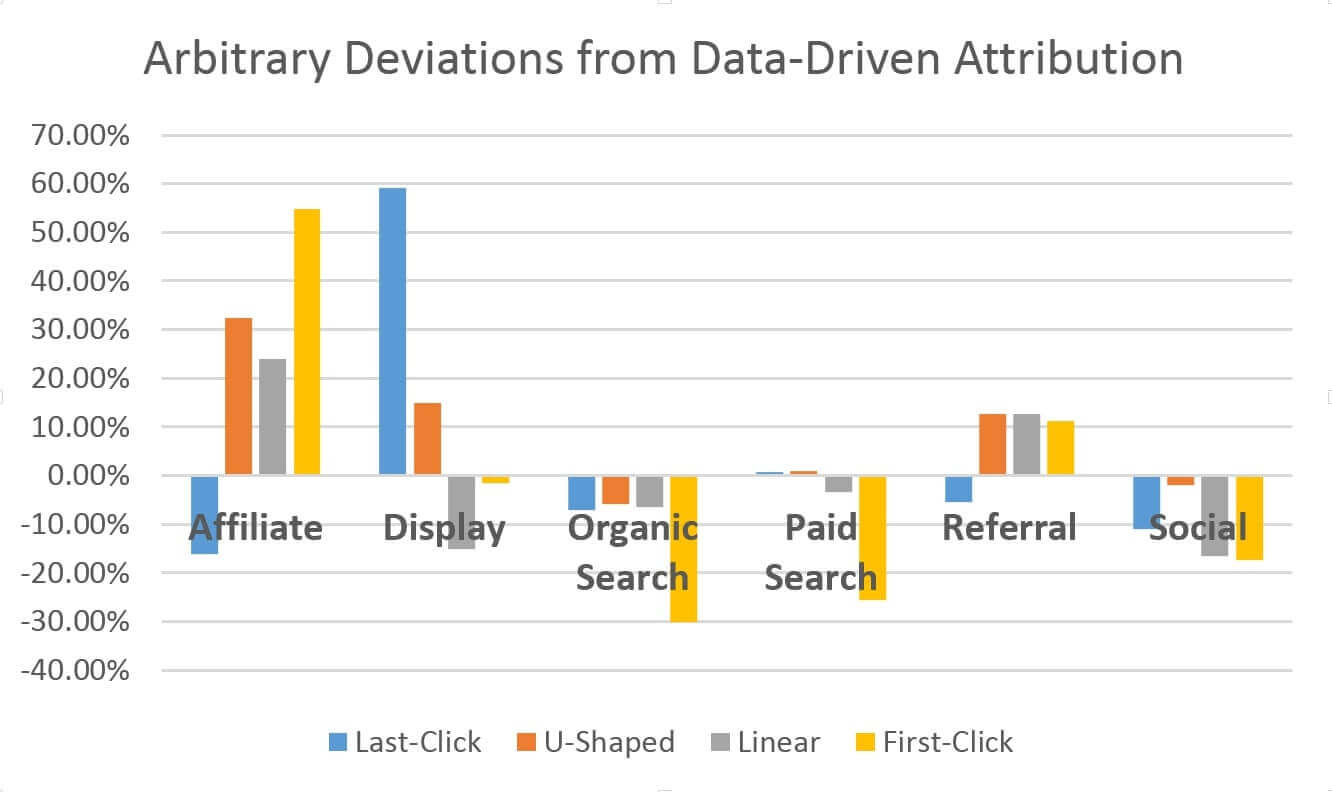Dangers of Static Attribution Models
When comparing infamous and wide-spread last-click attribution against a credible data-driven attribution, it becomes clear how dangerous sticking to last-click attribution can be. Looking at only the last marketing interaction before a conversion is similar to only paying the players that scored a touchdown in the NFL. Every experienced marketing manager knows that a last-click attribution is wrong and leads to suboptimal budget allocation and inefficient marketing management.
This has been propagated widely in many articles, at conferences and of course by many marketing consultants. The important question is just “how” wrong last-click attribution is? For example, how high the proportion of incorrectly attributed conversions there are.
As a provider of a data-driven and machine-learning based attribution modeling solution, we have the capability to calculate the answer. Specifically, we looked at all Adtriba clients to see how many conversions would be attributed to a channel based on last-click. We then compared this last-click attribution to the number of conversions attributed to the same channel according to the Adtriba attribution model.
Additionally we also looked at how much the number differed to three other common static attribution models: first-click, linear and u-shaped. The majority of marketers we speak to uses last-click attribution. But some also apply alternatives such as these static rules, because they seem less wrong than last-click.


59.10% median difference for Display/last-click means, that for 50% of the Adtriba clients Display was undervalued by at least 59.10% (e.g. Adtriba Attribution model: 1000 conversions, last-click model: 409 conversions) or more because of last-click.
For Organic Search and Social seems to be a trend of overvaluation through all static attribution models, but other than that there are no clear patterns that could be identified when looking at these stats. This indicates the aspect of arbitrariness of static attribution models.
The biggest failure of rule-based and static attribution models is, that they don’t take into account all the unsuccessful marketing touchpoints. This means that they do not account for the efficiency of a particular marketing campaign whatsoever. In Football you would always evaluate players by their efficiency, i.e. analyze their successful and unsuccessful moves. Mid-fielders get evaluated by what their passing-rate is, defensive players by how many direct combats they’ve won, etc.. By not doing so, analyzing customer journeys and marketing campaign efficiency is completely biased and from a data analytics perspective, plain wrong.
On average paid search brand campaigns are overvalued by 30%
There’s been quite a controversial and intense discussions regarding the right attribution when it comes to paid search brand campaigns. Many larger brands conducted tests and found that their branded search where being significantly overvalued (see for example this article). Branded searches tend to happen in the lower funnel of the customer’s journey, meaning close to the conversion. Obviously this leads to branded searches profiting from a last-click attribution and potentially being overvalued. We looked at whether we saw indications for this in our clients data and found, that on average paid search brand campaigns are overvalued by 30% by last-click when comparing it to the Adtriba data-driven model.
It’s crucial to understand that these are highly aggregated statistics, which only aim to illustrate how dangerous sticking to last-click (or any of the other static attribution) can be. These numbers are by no means actionable insights suitable to derive operative actions. Just because affiliate campaigns have been overvalued in aggregate doesn’t mean that spendings in all affiliates should be reduced and neither do these numbers justify increase spending in all display ad campaigns. In order to optimize budget allocations for campaigns and advertising, specific data-driven attribution models need to be applied.
The purpose of Attribution Modeling is not to generate at a singular and absolute truth. Rather working on attribution modeling is an ongoing process to greatly improve marketing decisions and marketing ROI. Moving away from static attribution models and starting with a data-driven approach means jumping ahead into the right direction of this process.